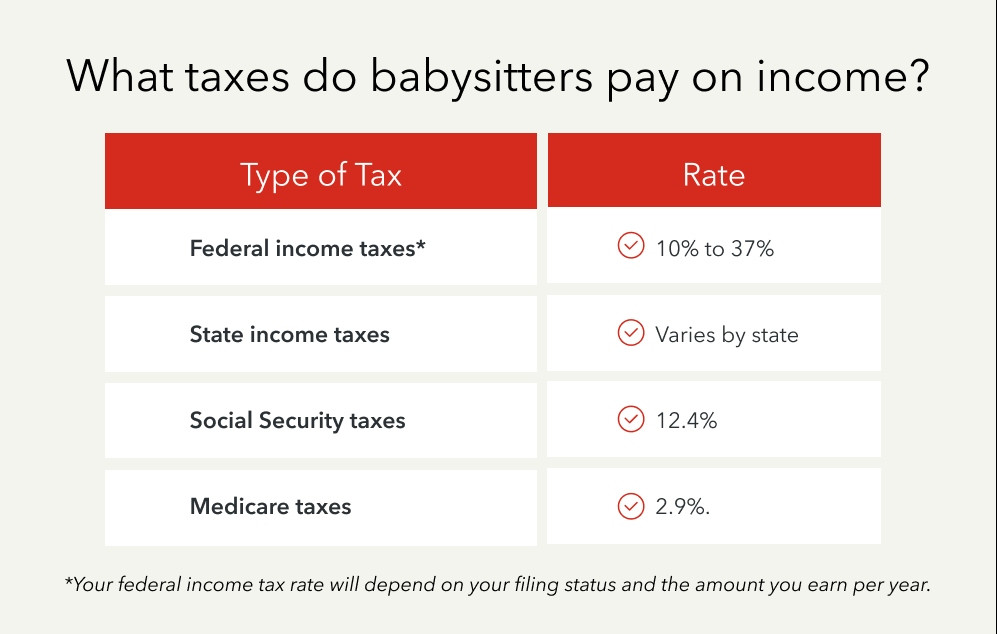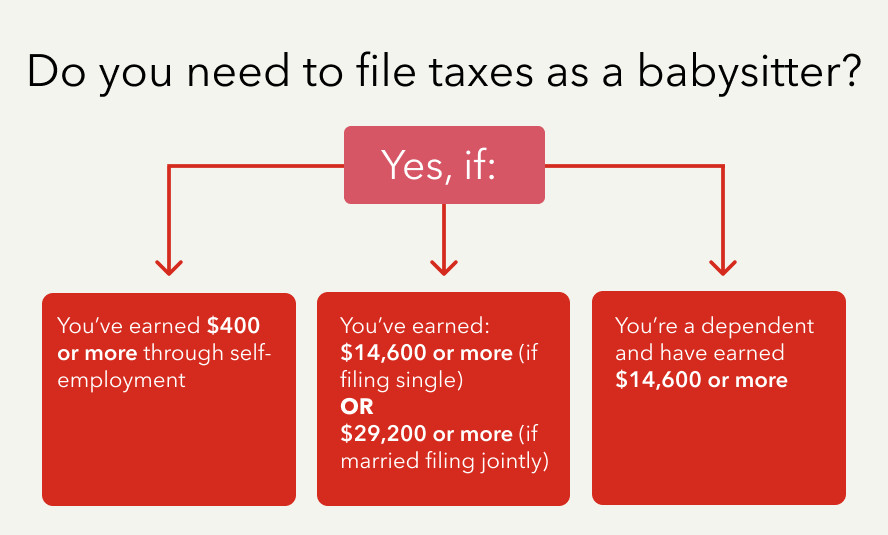Claiming babysitting income on taxes might seem daunting, but it’s a crucial step to ensure you’re compliant with IRS regulations and potentially unlock valuable deductions. At income-partners.net, we guide you through every aspect of reporting and claiming your earnings, providing clear steps to manage your babysitting finances effectively. Our expertise helps you understand tax obligations, maximize your financial benefits, and even discover partnership opportunities to boost your income through collaborative ventures and strategic financial planning.
1. Do Babysitters Have to Report Their Income on Taxes?
Yes, if you earn $400 or more as a babysitter, the IRS requires you to report this income on your taxes. This is because the IRS considers babysitting income as self-employment income. This means you’re responsible for both income tax and self-employment tax on your earnings. Even if you don’t receive a Form 1099-NEC, you’re still obligated to report all income. According to IRS guidelines, reporting all income, regardless of the amount, ensures transparency and accuracy in your tax filings, which helps avoid potential penalties and audits. For additional insights on income reporting and tax compliance, income-partners.net provides resources and partnership opportunities that can help you manage your finances more effectively.
1.1. Why the $400 Threshold Matters
The $400 threshold isn’t arbitrary. It represents the point at which the IRS considers your self-employment income significant enough to warrant taxation. Falling below this threshold means you’re not required to file a Schedule SE or pay self-employment taxes.
1.2. What Happens If You Don’t Report Your Income?
Failing to report your babysitting income can lead to penalties and interest charges from the IRS. Additionally, it could raise red flags and increase your chances of an audit. Honesty and accuracy are always the best policies when it comes to taxes.
1.3. Resources on income-partners.net
At income-partners.net, we provide resources to help you accurately report your income and explore potential tax deductions. Through strategic partnerships, you can also discover new avenues for increasing your earnings while staying compliant with tax regulations.
 Someone carefully counting a stack of bills
Someone carefully counting a stack of bills
2. Do Babysitters Have to Pay Taxes?
Yes, babysitters generally have to pay federal taxes, especially self-employment taxes, if their net earnings are over $400. This is similar to any other self-employed individual. How much you owe depends on factors like your total income, filing status, and eligible tax deductions. Remember, self-employment taxes cover Social Security and Medicare, which are typically withheld from employees’ paychecks. income-partners.net provides strategies to help manage these taxes effectively, including partnerships that may offer tax advantages or ways to increase your income to offset tax liabilities.
2.1. Understanding Self-Employment Tax
Self-employment tax consists of Social Security and Medicare taxes. For employees, these taxes are split between the employer and employee. However, as a self-employed individual, you’re responsible for paying both portions. The self-employment tax rate is 15.3% (12.4% for Social Security and 2.9% for Medicare) on the first $168,600 of your combined net earnings.
2.2. Factors Affecting Your Tax Liability
- Total Income: The more you earn, the higher your tax liability.
- Filing Status: Your filing status (single, married filing jointly, etc.) affects your tax bracket and standard deduction.
- Tax Deductions: Claiming eligible deductions can reduce your taxable income and lower your tax bill.
- Tax Credits: Tax credits directly reduce the amount of tax you owe.
2.3. Resources on income-partners.net
income-partners.net provides tools and resources to help you estimate your tax liability and identify potential deductions. We also connect you with financial experts who can provide personalized tax advice.
 Graphic outlining babysitter tax responsibilities
Graphic outlining babysitter tax responsibilities
3. Do Employers Have to Pay Taxes for Babysitters?
In some cases, families hiring babysitters may be considered household employers and responsible for withholding and paying taxes. This typically applies if the babysitter is considered a household employee, meaning the family has significant control over how the babysitter performs their duties. If you paid a babysitter $2,700 or more in 2024, you might have to withhold and pay employment taxes. Certain exceptions exist if the caregiver is a spouse, child under 21, parent, or someone under 18 whose principal occupation is not babysitting. Understanding these obligations can help you avoid legal and financial pitfalls. For further insights and assistance on tax responsibilities, income-partners.net provides resources and connects you with financial professionals who can offer personalized guidance and support.
3.1. Defining a Household Employee
A household employee is someone who works in or around your home, and you control not only what work is done but also how it is done. This distinguishes them from independent contractors who have more autonomy over their work.
3.2. Employer Responsibilities
If you’re classified as a household employer, your responsibilities include:
- Withholding Social Security, Medicare, and income taxes from the babysitter’s wages.
- Paying employer Social Security and Medicare taxes.
- Paying federal unemployment tax.
- Providing the babysitter with a Form W-2 at the end of the year.
3.3. Resources on income-partners.net
income-partners.net offers resources to help families understand their obligations as household employers. We also connect you with payroll service providers who can handle the complexities of household employment taxes.
4. Do Babysitters Need to File Taxes?
Yes, as a general rule, babysitters need to file taxes if their income exceeds certain thresholds. The IRS sets thresholds for those required to file. If you’re a dependent of someone else, you generally need to file if you’ve earned more than $14,600 from your work or have net self-employment income of $400 or more. Even if your income is below the filing threshold, filing a tax return might be beneficial, as you could be eligible for a tax refund. Filing taxes helps ensure compliance and can provide access to various tax benefits. income-partners.net can guide you through the filing process, ensuring you take advantage of all available deductions and credits while staying on the right side of the IRS.
4.1. Filing Requirements for Dependents
If you’re claimed as a dependent on someone else’s tax return, your filing requirements are different than those of independent individuals. Generally, you must file if your unearned income (e.g., interest, dividends) exceeds $1,300, your earned income exceeds $14,600, or your gross income (earned plus unearned) exceeds the larger of $1,300 or your earned income (up to $14,150) plus $450.
4.2. Filing Requirements for Independent Individuals
If you’re not a dependent, you generally must file a tax return if your gross income exceeds the standard deduction for your filing status. For example, in 2024, the standard deduction for single filers is $14,600.
4.3. Resources on income-partners.net
income-partners.net offers resources to help you determine whether you need to file a tax return and understand your filing requirements. We also provide access to tax preparation software and services.
 A graphic asking if babysitters need to file taxes
A graphic asking if babysitters need to file taxes
5. Which Forms Will You Receive for Babysitting Taxes?
As a babysitter, you might receive either Form W-2 or Form 1099-NEC, depending on your employment status. Typically, you’ll receive a 1099-NEC if you’re an independent contractor, but this isn’t always guaranteed if you didn’t meet the annual payment limit or $1,000 in a calendar quarter. If you’re considered a household employee, your employer will withhold taxes and issue a W-2 at the end of the year. income-partners.net ensures you understand which form to expect and how to use it correctly, helping you avoid filing errors and potential tax complications.
5.1. Understanding Form W-2
Form W-2, Wage and Tax Statement, is issued by employers to employees. It reports the employee’s annual wages and the amount of taxes withheld from their paychecks. If you’re a household employee, you’ll receive a W-2 from the family you work for.
5.2. Understanding Form 1099-NEC
Form 1099-NEC, Nonemployee Compensation, is issued to independent contractors who receive payments of $600 or more from a business during the year. If you’re an independent contractor, you may receive a 1099-NEC from the families you babysit for.
5.3. What If You Don’t Receive a Form?
Even if you don’t receive a W-2 or 1099-NEC, you’re still responsible for reporting all your income to the IRS. Keep accurate records of your earnings, such as a log of your payments or copies of your invoices.
5.4. Resources on income-partners.net
income-partners.net provides resources to help you understand the different tax forms and how to use them to file your tax return. We also offer tools to help you track your income and expenses.
 Babysitter playing with a toddler on the floor
Babysitter playing with a toddler on the floor
6. How to Report Babysitting Income
To report babysitting income, you’ll typically use Form 1040, Schedule C if you’re self-employed, or Form 1040 with a W-2 if you’re a household employee. Self-employed individuals also need to complete Schedule SE for Social Security and Medicare taxes, which make up self-employment taxes. If you’re a household employee, you’ll use the W-2 provided by your employer to fill out Form 1040. Correctly reporting your income is crucial for tax compliance and avoiding potential penalties. With income-partners.net, you gain access to clear instructions and resources, simplifying the reporting process and ensuring accuracy in your tax filings.
6.1. Reporting as a Self-Employed Individual
If you’re an independent contractor, you’ll report your babysitting income on Schedule C, Profit or Loss From Business (Sole Proprietorship). This form is used to calculate your net profit or loss from your business. You’ll also need to complete Schedule SE, Self-Employment Tax, to calculate the amount of Social Security and Medicare taxes you owe.
6.2. Reporting as a Household Employee
If you’re a household employee, you’ll report your wages on Form 1040, U.S. Individual Income Tax Return. You’ll use the information on your W-2 to complete this form.
6.3. Deductible Expenses
As a self-employed individual, you can deduct certain business expenses from your gross income to reduce your taxable income. Common deductible expenses for babysitters include:
- Advertising: Costs associated with promoting your babysitting services.
- Supplies: Expenses for toys, games, and other supplies used for babysitting.
- Transportation: Costs associated with traveling to and from babysitting jobs.
- Training: Expenses for courses or workshops that enhance your babysitting skills.
6.4. Resources on income-partners.net
income-partners.net provides resources to help you understand how to report your babysitting income and claim eligible deductions. We also offer access to tax preparation software and services.
7. How Do You Calculate Babysitter Taxes?
Babysitter taxes are calculated based on your tax bracket, with different rates for different income levels. Self-employment taxes include Social Security and Medicare taxes, with rates of 12.4% and 2.9% respectively. Only your net income is taxed. To estimate your marginal tax rate, you can use online tax calculators. Understanding how these taxes are calculated is essential for financial planning and tax preparation. income-partners.net provides tools and resources to help you estimate your tax obligations accurately, so you can manage your finances with confidence.
7.1. Calculating Income Tax
Your income tax liability depends on your taxable income and your tax bracket. The U.S. tax system uses a progressive tax system, meaning that higher income levels are taxed at higher rates.
7.2. Calculating Self-Employment Tax
Self-employment tax is calculated on your net earnings from self-employment. The self-employment tax rate is 15.3% (12.4% for Social Security and 2.9% for Medicare) on the first $168,600 of your combined net earnings. You can deduct one-half of your self-employment tax from your gross income.
7.3. Resources on income-partners.net
income-partners.net provides tools to help you calculate your income tax and self-employment tax. We also connect you with financial advisors who can provide personalized tax planning advice.
8. How to Pay Estimated Taxes on Babysitting Income
If you expect to owe $1,000 or more in taxes, consider paying estimated taxes quarterly to avoid penalties. Estimated taxes are paid at the end of each quarter, making it easier to manage your tax obligations and avoid surprises when filing your annual tax return. You can use Form 1040-ES, Estimated Tax for Individuals, to estimate your quarterly taxes. income-partners.net offers resources and guidance to help you navigate the process of paying estimated taxes, ensuring you stay compliant with IRS regulations and avoid potential fines.
8.1. Determining If You Need to Pay Estimated Taxes
You generally need to pay estimated taxes if you expect to owe at least $1,000 in taxes when you file your return and if your withholding and credits won’t cover at least 90% of your tax liability for the year.
8.2. Quarterly Payment Deadlines
The quarterly payment deadlines for estimated taxes are:
- Quarter 1: April 15
- Quarter 2: June 15
- Quarter 3: September 15
- Quarter 4: January 15 of the following year
8.3. Methods of Payment
You can pay your estimated taxes online, by phone, or by mail. The IRS recommends paying online for faster and more secure processing.
8.4. Resources on income-partners.net
income-partners.net provides resources to help you determine whether you need to pay estimated taxes and understand the payment deadlines. We also offer tools to help you make your payments online.
9. Maximizing Tax Deductions and Credits for Babysitters
To minimize your tax liability, take advantage of all eligible deductions and credits. Common deductions include business expenses like advertising, supplies, and transportation. Credits like the Child and Dependent Care Credit can also significantly reduce your tax burden. Understanding and utilizing these deductions and credits can help you keep more of your earnings. income-partners.net offers resources and expert advice to help you identify and claim all applicable tax benefits, maximizing your savings.
9.1. Common Deductions for Babysitters
- Business Expenses: These include costs directly related to your babysitting business, such as supplies, advertising, and transportation.
- Home Office Deduction: If you use a portion of your home exclusively and regularly for your babysitting business, you may be able to deduct a portion of your home-related expenses, such as rent, utilities, and insurance.
- Self-Employment Tax Deduction: You can deduct one-half of your self-employment tax from your gross income.
- Health Insurance Deduction: If you’re self-employed and pay for your own health insurance, you may be able to deduct the premiums you pay.
9.2. Available Tax Credits
- Child and Dependent Care Credit: If you paid someone to care for your child or other qualifying individual so you could work or look for work, you may be able to claim the Child and Dependent Care Credit.
- Earned Income Tax Credit (EITC): If you have low to moderate income, you may be eligible for the EITC, which can reduce the amount of tax you owe and potentially result in a refund.
9.3. Resources on income-partners.net
income-partners.net provides resources to help you identify and claim eligible deductions and credits. We also connect you with tax professionals who can provide personalized advice and assistance.
10. Keeping Accurate Records for Tax Purposes
Maintaining meticulous records of your income and expenses is vital for accurate tax reporting and maximizing deductions. This includes tracking all payments received, expenses incurred, and relevant documentation. Organized records make tax preparation easier and help you substantiate your claims in case of an audit. income-partners.net offers tools and resources to help you keep your financial records in order, ensuring a smooth tax filing process.
10.1. What Records to Keep
- Income Records: Keep track of all payments you receive for babysitting services, including the date, amount, and payer.
- Expense Records: Keep receipts and documentation for all business-related expenses, such as supplies, advertising, and transportation.
- Mileage Log: If you use your car for business purposes, keep a mileage log to track the dates, destinations, and business miles you drive.
- Tax Forms: Keep copies of all tax forms you receive, such as W-2s and 1099-NECs.
10.2. Tools for Record Keeping
- Spreadsheets: Use a spreadsheet to track your income and expenses.
- Accounting Software: Consider using accounting software like QuickBooks Self-Employed to manage your finances.
- Mobile Apps: Use mobile apps to track your mileage and expenses on the go.
10.3. Resources on income-partners.net
income-partners.net provides resources to help you set up a record-keeping system and stay organized. We also offer access to accounting software and mobile apps.
11. The Role of Partnerships in Boosting Babysitting Income
Collaborating with other professionals and businesses can significantly enhance your babysitting income. Forming strategic alliances with childcare centers, schools, or local businesses can provide a steady stream of referrals and opportunities. Additionally, partnering with financial advisors or tax professionals can offer value-added services to your clients. income-partners.net specializes in connecting you with the right partners to expand your business and increase your earnings.
11.1. Benefits of Strategic Partnerships
- Increased Referrals: Partnerships can lead to a steady flow of new clients and opportunities.
- Expanded Services: Collaborations can enable you to offer a broader range of services to your clients.
- Enhanced Credibility: Partnering with reputable organizations can enhance your credibility and reputation.
11.2. Types of Potential Partners
- Childcare Centers: Collaborate with childcare centers to provide after-hours or weekend babysitting services.
- Schools: Partner with schools to offer babysitting services during school events or parent-teacher conferences.
- Local Businesses: Collaborate with local businesses to offer childcare services to their employees or customers.
- Financial Advisors and Tax Professionals: Partner with financial advisors and tax professionals to offer value-added services to your clients.
11.3. Resources on income-partners.net
income-partners.net connects you with a network of potential partners and provides resources to help you establish and manage successful partnerships.
12. Navigating State and Local Taxes on Babysitting Income
In addition to federal taxes, be aware of any state and local taxes that may apply to your babysitting income. These can include state income tax, local income tax, and sales tax on certain services. Understanding your state and local tax obligations is essential for compliance. income-partners.net provides resources and connections to local tax professionals to help you navigate these requirements.
12.1. State Income Tax
Most states have an income tax, which is calculated based on your taxable income. The state income tax rate varies depending on your income level and filing status.
12.2. Local Income Tax
Some cities and counties also have an income tax, which is calculated based on your taxable income. The local income tax rate varies depending on your location.
12.3. Sales Tax
Some states and localities impose a sales tax on certain services. Check with your state and local tax authorities to determine if your babysitting services are subject to sales tax.
12.4. Resources on income-partners.net
income-partners.net provides resources to help you understand your state and local tax obligations. We also connect you with local tax professionals who can provide personalized advice and assistance.
13. Common Mistakes to Avoid When Filing Babysitting Taxes
Avoid these common errors when filing your babysitting taxes to prevent penalties and ensure accuracy. These include failing to report all income, neglecting to claim eligible deductions, and making errors in calculations. Accurate and thorough tax preparation is crucial for financial health. income-partners.net provides checklists and resources to help you avoid these mistakes and file your taxes correctly.
13.1. Failing to Report All Income
Be sure to report all income you receive from babysitting, even if you don’t receive a W-2 or 1099-NEC.
13.2. Neglecting to Claim Eligible Deductions
Take advantage of all eligible deductions to reduce your taxable income.
13.3. Making Errors in Calculations
Double-check your calculations to ensure accuracy.
13.4. Missing the Filing Deadline
File your tax return on time to avoid penalties.
13.5. Resources on income-partners.net
income-partners.net provides resources to help you avoid common tax filing mistakes. We also offer access to tax preparation software and services.
14. Utilizing Tax Preparation Software and Services
Tax preparation software and professional services can streamline the filing process and ensure accuracy. Software options like TurboTax and H&R Block offer user-friendly interfaces and step-by-step guidance. Alternatively, hiring a tax professional can provide personalized advice and handle complex tax situations. income-partners.net offers connections to trusted tax professionals and resources for selecting the right tax preparation tools.
14.1. Benefits of Tax Preparation Software
- User-friendly interface
- Step-by-step guidance
- Automatic calculations
- Access to tax tips and resources
14.2. Benefits of Hiring a Tax Professional
- Personalized advice
- Expert knowledge of tax laws
- Assistance with complex tax situations
- Representation in case of an audit
14.3. Resources on income-partners.net
income-partners.net provides resources to help you select the right tax preparation software or find a qualified tax professional.
15. Staying Updated on Tax Law Changes
Tax laws are subject to change, so stay informed about updates that could affect your babysitting income. Follow IRS announcements, consult with tax professionals, and utilize reliable online resources. Keeping up-to-date ensures you remain compliant and take advantage of any new tax benefits. income-partners.net provides timely updates and resources to help you stay on top of tax law changes.
15.1. Following IRS Announcements
The IRS regularly issues announcements, publications, and other guidance on tax law changes.
15.2. Consulting with Tax Professionals
Tax professionals can provide personalized advice and keep you informed about tax law changes.
15.3. Utilizing Reliable Online Resources
There are many reliable online resources that provide information on tax law changes, such as the IRS website and reputable tax news websites.
15.4. Resources on income-partners.net
income-partners.net provides resources to help you stay updated on tax law changes. We also connect you with tax professionals who can provide personalized advice.
FAQ: Claiming Babysitting Income on Taxes
1. What income is considered taxable for babysitters?
Any payment you receive for your babysitting services is considered taxable income, whether it’s cash, check, or other forms of compensation.
2. How do I prove my babysitting income if I don’t receive a 1099 form?
Keep a detailed record of your earnings, including dates, amounts, and the names of the families you babysit for. Bank statements or payment apps can also serve as proof of income.
3. Can I deduct expenses like gas or mileage when filing my taxes?
Yes, if you use your car for business purposes, such as traveling to and from babysitting jobs, you can deduct the actual expenses or take the standard mileage rate.
4. What happens if I underreport my babysitting income?
Underreporting income can lead to penalties, interest charges, and potential audits. It’s always best to report all your income accurately.
5. Is it better to pay estimated taxes quarterly or annually?
Paying estimated taxes quarterly helps you avoid penalties and makes it easier to manage your tax obligations.
6. Can I deduct expenses for toys or games used while babysitting?
Yes, expenses for supplies used directly in your babysitting business are deductible.
7. What is the self-employment tax rate for babysitters?
The self-employment tax rate is 15.3% (12.4% for Social Security and 2.9% for Medicare) on the first $168,600 of your combined net earnings.
8. How does filing jointly with my spouse affect my babysitting income taxes?
Filing jointly can change your tax bracket and increase your standard deduction, potentially lowering your overall tax liability.
9. What should I do if I receive conflicting tax advice?
Consult with a qualified tax professional or refer to official IRS publications for clarification.
10. Where can I find the most current information about tax laws for self-employed individuals?
The IRS website (irs.gov) is the most reliable source for up-to-date information on tax laws for self-employed individuals.
Claiming babysitting income on taxes can seem complicated, but with the right resources and information, it’s manageable. Visit income-partners.net today to discover how to navigate tax compliance and unlock partnership opportunities for greater financial success. Connect with us at 1 University Station, Austin, TX 78712, United States, call +1 (512) 471-3434, or explore our website at income-partners.net to learn more about how we can help you thrive in your business endeavors.
